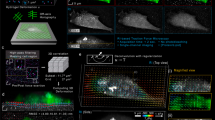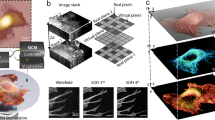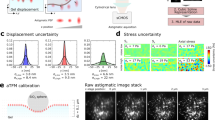Abstract
The mechanical rigidity of cells and adhesion forces between cells are important in various biological processes, including cell differentiation, proliferation and tissue organization. Atomic force microscopy has emerged as a powerful tool to quantify the mechanical properties of individual cells and adhesion forces between cells. Here we demonstrate an instrument that combines atomic force microscopy with a side-view fluorescent imaging path that enables direct imaging of cellular deformation and cytoskeletal rearrangements along the axis of loading. With this instrument, we directly observed cell shape under mechanical load, correlated changes in shape with force-induced ruptures and imaged formation of membrane tethers during cell-cell adhesion measurements. Additionally, we observed cytoskeletal reorganization and stress-fiber formation while measuring the contractile force of an individual cell. This instrument can be a useful tool for understanding the role of mechanics in biological processes.
This is a preview of subscription content, access via your institution
Access options
Subscribe to this journal
Receive 12 print issues and online access
$259.00 per year
only $21.58 per issue
Buy this article
- Purchase on Springer Link
- Instant access to full article PDF
Prices may be subject to local taxes which are calculated during checkout




Similar content being viewed by others
References
Engler, A.J., Sen, S., Sweeney, H.L. & Discher, D.E. Matrix elasticity directs stem cell lineage specification. Cell 126, 677–689 (2006).
Paszek, M.J. et al. Tensional homeostasis and the malignant phenotype. Cancer Cell 8, 241–254 (2005).
Krieg, M. et al. Tensile forces govern germ-layer organization in zebrafish. Nat. Cell Biol. 10, 429–436 (2008).
Bausch, A.R., Moller, W. & Sackmann, E. Measurement of local viscoelasticity and forces in living cells by magnetic tweezers. Biophys. J. 76, 573–579 (1999).
Shao, J.Y. & Hochmuth, R.M. Micropipette suction for measuring piconewton forces of adhesion and tether formation from neutrophil membranes. Biophys. J. 71, 2892–2901 (1996).
Evans, E., Heinrich, V., Leung, A. & Kinoshita, K. Nano- to microscale dynamics of P-selectin detachment from leukocyte interfaces. I. Membrane separation from the cytoskeleton. Biophys. J. 88, 2288–2298 (2005).
Desprat, N., Richert, A., Simeon, J. & Asnacios, A. Creep function of a single living cell. Biophys. J. 88, 2224–2233 (2005).
Wottawah, F. et al. Optical rheology of biological cells. Phys. Rev. Lett. 94, 098103–1–098103–4 (2005).
Binnig, G., Quate, C.F. & Gerber, C. Atomic force microscope. Phys. Rev. Lett. 56, 930–933 (1986).
Radmacher, M., Fritz, M., Kacher, C.M., Cleveland, J.P. & Hansma, P.K. Measuring the viscoelastic properties of human platelets with the atomic force microscope. Biophys. J. 70, 556–567 (1996).
Alcaraz, J. et al. Microrheology of human lung epithelial cells measured by atomic force microscopy. Biophys. J. 84, 2071–2079 (2003).
Benoit, M., Gabriel, D., Gerisch, G. & Gaub, H.E. Discrete interactions in cell adhesion measured by single-molecule force spectroscopy. Nat. Cell Biol. 2, 313–317 (2000).
Panorchan, P. et al. Single-molecule analysis of cadherin-mediated cell-cell adhesion. J. Cell Sci. 119, 66–74 (2006).
Charras, G.T. & Horton, M.A. Single cell mechanotransduction and its modulation analyzed by atomic force microscope indentation. Biophys. J. 82, 2970–2981 (2002).
Canetta, E., Duperray, A., Leyrat, A. & Verdier, C. Measuring cell viscoelastic properties using a force-spectrometer: Influence of protein-cytoplasm interactions. Biorheology 42, 321–333 (2005).
Heinrich, V. & Ounkomol, C. Biophysics in reverse: Using blood cells to accurately calibrate force-microscopy cantilevers. Appl. Phys. Lett. 92, 153902–1–153902–3 (2008).
Ounkomol, C., Xie, H., Dayton, P.A. & Heinrich, V. Versatile horizontal force probe for mechanical tests on pipette-held cells, particles, and membrane capsules. Biophys. J. 96, 1218–1231 (2009).
Vestweber, D. Adhesion and signaling molecules controlling the transmigration of leukocytes through endothelium. Immunol. Rev. 218, 178–196 (2007).
Girdhar, G. & Shao, J.Y. Simultaneous tether extraction from endothelial cells and leukocytes: Observation, mechanics, and significance. Biophys. J. 93, 4041–4052 (2007).
Gerszten, R.E. et al. MCP-1 and IL-8 trigger firm adhesion of monocytes to vascular endothelium under flow conditions. Nature 398, 718–723 (1999).
Zhang, X. et al. Atomic force microscopy measurement of leukocyte-endothelial interaction. Am. J. Physiol. Heart Circ. Physiol. 286, H359–H367 (2004).
Kunkel, E.J., Dunne, J.L. & Ley, K. Leukocyte arrest during cytokine-dependent inflammation in vivo. J. Immunol. 164, 3301–3308 (2000).
Derenyi, I., Julicher, F. & Prost, J. Formation and interaction of membrane tubes. Phys. Rev. Lett. 88, 238101–1–238101–4 (2002).
Harris, A.K., Wild, P. & Stopak, D. Silicone-rubber substrata—new wrinkle in the study of cell locomotion. Science 208, 177–179 (1980).
Chen, C.S. Mechanotransduction—a field pulling together? J. Cell Sci. 121, 3285–3292 (2008).
Hotulainen, P. & Lappalainen, P. Stress fibers are generated by two distinct actin assembly mechanisms in motile cells. J. Cell Biol. 173, 383–394 (2006).
Chu, Y.S. et al. Force measurements in E-cadherin-mediated cell doublets reveal rapid adhesion strengthened by actin cytoskeleton remodeling through Rac and Cdc42. J. Cell Biol. 167, 1183–1194 (2004).
Parekh, S.H., Chaudhuri, O., Theriot, J.A. & Fletcher, D.A. Loading history determines the velocity of actin-network growth. Nat. Cell Biol. 7, 1219–1223 (2005).
Acknowledgements
We thank J.W. Shaevitz, M. Van Duijn, M.J. Rosenbluth, A. Crow and all members of the Fletcher laboratory for helpful discussions, and B. Zuchero (University of California San Francisco) for the gift of GFP-transfected U2OS cells used in initial experiments. This work was supported by a US National Science Foundation graduate research fellowship (O.C.); a US National Institutes of Health National Research Service Award, Hammond research fellowship and Hartwell biomedical research fellowship (W.A.L.), and a National Institutes of Health R01 grant (D.A.F.).
Author information
Authors and Affiliations
Corresponding author
Supplementary information
Supplementary Text and Figures
Supplementary Figures 1–2 (PDF 3214 kb)
Supplementary Video 1
Side-view video of leukocyte shape during leukocyte cell-endothelial cell adhesion measurement. This video is taken from the experiment described in Figure 2. Video is composed of 41 images taken in intervals of 1 second. Scale bar, 10 μm. (MOV 2232 kb)
Supplementary Video 2
Side-view video of U2OS contraction. This video is taken from the experiment described in Figure 3. Images of GFP-actin are taken approximately every 30 seconds over 17 minutes. Scale bar, 10 μm. (MOV 4624 kb)
Supplementary Video 3
Side-view video of U2OS contraction experiment showing rupturing of adhesion to surface. As in the experiment described in Figure 4, the U2OS cell pulls the cantilever down towards the sample surface as it contracts, resulting in an increasing tensional force applied by the cantilever across the cell. Images of GFP-actin are taken approximately every 15 seconds over 63 minutes. Fibers are observed to form in the video, and de-adhesion occurs due to rupture of the adhesion between the U2OS cell and the fibronectin-coated surface. Scale bar, 10 μm. (MOV 2788 kb)
Rights and permissions
About this article
Cite this article
Chaudhuri, O., Parekh, S., Lam, W. et al. Combined atomic force microscopy and side-view optical imaging for mechanical studies of cells. Nat Methods 6, 383–387 (2009). https://doi.org/10.1038/nmeth.1320
Received:
Accepted:
Published:
Issue Date:
DOI: https://doi.org/10.1038/nmeth.1320
This article is cited by
-
Force spectroscopy of single cells using atomic force microscopy
Nature Reviews Methods Primers (2021)
-
3D mechanical characterization of single cells and small organisms using acoustic manipulation and force microscopy
Nature Communications (2021)
-
Bone fracture healing: perspectives according to molecular basis
Journal of Bone and Mineral Metabolism (2021)
-
Probing nanomechanical responses of cell membranes
Scientific Reports (2020)
-
Oblique-plane single-molecule localization microscopy for tissues and small intact animals
Nature Methods (2019)



